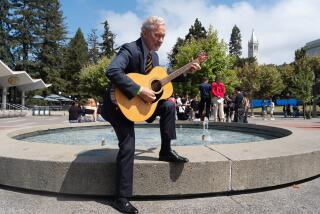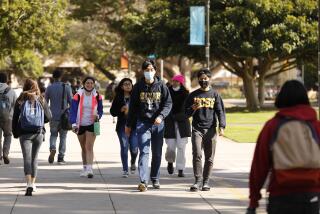The Grand Tradition of University Faculty Clubs
- Share via
Einstein’s ghost hovers between the arches at Caltech’s Athenaeum, where Nobel laureates lunch alongside post-docs and assistant professors. Likewise, in the faculty clubs at Berkeley and Stanford, UCLA and USC, the shades of scholars past remind diners that they are part of an academic elite.
Faculty clubs are as ubiquitous on campuses as libraries. Mostly for dining, they are a phenomenon that started in the West and moved East and may be California’s most memorable contribution to the world of academe. There are still no faculty clubs at Oxford and Cambridge, and those at the Ivys are of recent vintage compared with California’s venerable establishments.
A sunny winter day in Pasadena and the courtyard of the Italianate villa is filled with scholars of every calling--except biologists. An inside observer suggests “they are too hot in pursuit of Nobel prizes to take time off to eat.”
Excellent Menus
Those who do, enjoy an excellent and changing menu. The club’s manager, Abel Ramirez, explains: “The members are sophisticated and well-traveled. They enjoy good food and expect it.” Perhaps it was Ramirez’s early years studying civil engineering that keep him so attuned to the faculty he serves. On Oct. 1, when an earthquake of 5.9 magnitude struck the Los Angeles area, Ramirez correctly predicted a surge in lunch reservations. “They often crowd the place on earthquake days,” he said.
At the Stanford Faculty Club, the food reflects a different set of values. The club’s manager, Mario Scherrer, a Swiss graduate of hotel-management training, planned the menu in 1978 with the Stanford Heart Disease Prevention Program. Alongside each item is a code indicating its calorie, saturated fat and cholesterol content. “Before the code identified hamburgers as FF (between 4 and 7 grams of saturated fat), 900 calories and CCC (between 101 and 150 milligrams of cholesterol), the club sold 46 a week. Today we are lucky to sell six,” Scherrer said.
When the Stanford club was incorporated in 1898, the campus was still a farm--remote from anything like a restaurant. The men--and women--of the faculty had been brown-bagging it on the curb until the men founded the club in a ramshackle wooden building. Even in those early days the university was coeducational, but the by-laws of the club permitted only male college graduates, scholars or scientists to join.
Times change. Today an elegant glass-and-redwood building welcomes faculty and staff of both sexes. But no one else. Neither alumni status nor a large contribution warrants membership.
To Boost Morale
The Stanford club was started to “raise the morale” of professors such as Thorstein Veblen, who felt exiled from culture.
Across the San Francisco Bay at the University of California in Berkeley, they incorporated a faculty club only four years later, in 1902, but with a different goal. They wanted to maintain an intellectual community and feared that specialization, “the Ph.D octopus” was spoiling the atmosphere, and invited all alumni and faculty--except women--to join. The proper atmosphere was provided by Bernard Maybeck, who volunteered to design the great redwood hall, which is the core of the present building.
The female faculty chafed at their exclusion, and in 1919, the 66 women on the faculty hired Julia Morgan, who also designed San Simeon, to design the Women’s Faculty Club. Reminiscent of a New England Inn, the sunny rooms and light cuisine compete today with the Maybeck building for faculty members of both sexes.
This genteel style was the standard in 1920 when Throop Polytechnic was reorganized as the California Institute of Technology. The three founders, Robert Milikan, Arthur Noyes and George Hale, wanted a club, but not just any club. It had to match their self-images. The need was met in 1929 by a gift of stock, which, cashed in before the crash, provided half a million dollars for construction in the deflation of the Depression.
Caltech hired Gordon Kaufman (who also designed the Los Angeles Times building and the Santa Anita Race Track) to build a palazzo in which the coffered ceilings of the dining halls are painted in the Renaissance style and opulent Oriental rugs cover the floors. They dubbed it the Athenaeum in emulation of the London club, which described itself as a gathering place for “individuals known for their scientific or literary attainments, artists of eminence . . . .”
Neighboring ‘Thinkers’ Invited
From the start, Caltech offered membership in the Athenaeum to neighboring “thinkers,” including the astronomers at Mt. Wilson and humanists at the Huntington Library and Art Gallery. As befits a club for scientists, a profession in which some of the best work is done by the young, they also offered membership to graduate students “over the age of 21” (a problem at Caltech where extremely precocious students have more than occasionally begun the graduate study of mathematics or physics in their late teens).
Today it is open to observers at Mt. Palomar, the staff of the Jet Propulsion Laboratory and a select group of patrons who are made Associates in return for a generous contribution.
Less Decorum Noted
But decorum is not as conservative as decor. There is no dress code anymore, though ties and jackets are encouraged at night. A fantasy of a club, it was transformed in the film “Beverly Hills Cop” into the businessmen’s club that Eddie Murphy invaded in his quest for justice.
The Athenaeum, and the Stanford and Berkeley clubs exude a sense of privilege. Money is seldom seen. Members sign for everything. Elegant and exclusive, these faculty clubs reflect how some academics see themselves. For theirs is a profession--more than any other--whose members feel an enormous discrepancy between salary and status.
“Professors are the least privileged members of the privileged classes,” psychologist James Cattell noted.
The gentility of academia altered after World War II. The UC system exploded in a profusion of new and expanded campuses and the University of Southern California began carving a tonier image for itself.
The Faculty Center that opened at UCLA in 1959, and the one at USC in 1960, are a far cry from the clubs built earlier in the century. Their generic “campus” architecture offers no tonic for the soul and the barely mediocre food is served in the ambiance of an airline terminal.
Encourages Encounters
Yet they too play a part in the lives of their faculties. There are often “open” tables where individuals from different departments can dine and chat alongside scholars who they might not otherwise encounter. Conversations may open the way for exciting debate, or may focus on a mundane exchange of telephone numbers of masons and plasterers. Then there are “closed” tables, spots unofficially reserved where the elite within the elite--deans, provosts and distinguished guests--can be seen together.
At Stanford, the table near the door is reserved on Fridays for lawyers, while the chemists and former club presidents meet downstairs. At Berkeley, the Miller Scholars--scientists tapped as especially gifted--eat together, and no one dares join them to break bread.
Who sits with whom at the faculty club can provide clues to the whole academic power structure and promotes tea-leaf readings in the manner of news of Nancy Reagan’s guest lists.
An Informal Atmosphere
In spite of the real power lunches that occur regularly at these clubs, they possess an informal atmosphere no ordinary private club can equal. The waiters, undergraduates with badges indicating their majors, dissolve all sense of social barrier between the server and those being served.
The real barrier is between the university and outsiders, no matter their status.
At their best, faculty clubs are an island in a harried world where newspapers and journals lie on oak tables before an open fireplace. At their worst, they are just another hall available for weddings and Bar Mitzvas at a price competitive with the Holiday Inn down the road.
Yet even those with unprepossessing facilities like UCLA have exchange privileges with clubs at universities throughout the United States and Canada. Academia is not necessarily luxurious, but on some campuses, the faculty club is one of the nicer perks.






